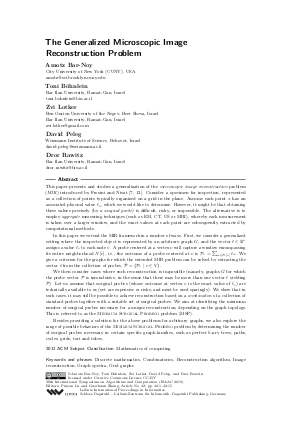The Generalized Microscopic Image Reconstruction Problem
Authors Amotz Bar-Noy, Toni Böhnlein, Zvi Lotker, David Peleg, Dror Rawitz
-
Part of:
Volume:
30th International Symposium on Algorithms and Computation (ISAAC 2019)
Part of: Series: Leibniz International Proceedings in Informatics (LIPIcs)
Part of: Conference: International Symposium on Algorithms and Computation (ISAAC) - License:
 Creative Commons Attribution 3.0 Unported license
Creative Commons Attribution 3.0 Unported license
- Publication Date: 2019-11-28
File

PDF
LIPIcs.ISAAC.2019.42.pdf
- Filesize: 489 kB
- 15 pages
Document Identifiers
Subject Classification
ACM Subject Classification
- Mathematics of computing
Keywords
- Discrete mathematics
- Combinatorics
- Reconstruction algorithm
- Image reconstruction
- Graph spectra
- Grid graphs
Metrics
- Access Statistics
-
Total Accesses (updated on a weekly basis)
0Document
0Metadata
Abstract
This paper presents and studies a generalization of the microscopic image reconstruction problem (MIR) introduced by Frosini and Nivat [Andrea Frosini and Maurice Nivat, 2007; Nivat, 2002]. Consider a specimen for inspection, represented as a collection of points typically organized on a grid in the plane. Assume each point x has an associated physical value l_x, which we would like to determine. However, it might be that obtaining these values precisely (by a surgical probe) is difficult, risky, or impossible. The alternative is to employ aggregate measuring techniques (such as EM, CT, US or MRI), whereby each measurement is taken over a larger window, and the exact values at each point are subsequently extracted by computational methods.
In this paper we extend the MIR framework in a number of ways. First, we consider a generalized setting where the inspected object is represented by an arbitrary graph G, and the vector l in R^n assigns a value l_v to each node v. A probe centered at a vertex v will capture a window encompassing its entire neighborhood N[v], i.e., the outcome of a probe centered at v is P_v = sum_{w in N[v]} l_w. We give a criterion for the graphs for which the extended MIR problem can be solved by extracting the vector l from the collection of probes, P^- = {P_v | v in V}.
We then consider cases where such reconstruction is impossible (namely, graphs G for which the probe vector P is inconclusive, in the sense that there may be more than one vector l yielding P). Let us assume that surgical probes (whose outcome at vertex v is the exact value of l_v) are technically available to us (yet are expensive or risky, and must be used sparingly). We show that in such cases, it may still be possible to achieve reconstruction based on a combination of a collection of standard probes together with a suitable set of surgical probes. We aim at identifying the minimum number of surgical probes necessary for a unique reconstruction, depending on the graph topology. This is referred to as the Minimum Surgical Probing problem (MSP).
Besides providing a solution for the above problems for arbitrary graphs, we also explore the range of possible behaviors of the Minimum Surgical Probing problem by determining the number of surgical probes necessary in certain specific graph families, such as perfect k-ary trees, paths, cycles, grids, tori and tubes.
Cite As Get BibTex
Amotz Bar-Noy, Toni Böhnlein, Zvi Lotker, David Peleg, and Dror Rawitz. The Generalized Microscopic Image Reconstruction Problem. In 30th International Symposium on Algorithms and Computation (ISAAC 2019). Leibniz International Proceedings in Informatics (LIPIcs), Volume 149, pp. 42:1-42:15, Schloss Dagstuhl – Leibniz-Zentrum für Informatik (2019)
https://doi.org/10.4230/LIPIcs.ISAAC.2019.42
BibTex
@InProceedings{barnoy_et_al:LIPIcs.ISAAC.2019.42,
author = {Bar-Noy, Amotz and B\"{o}hnlein, Toni and Lotker, Zvi and Peleg, David and Rawitz, Dror},
title = {{The Generalized Microscopic Image Reconstruction Problem}},
booktitle = {30th International Symposium on Algorithms and Computation (ISAAC 2019)},
pages = {42:1--42:15},
series = {Leibniz International Proceedings in Informatics (LIPIcs)},
ISBN = {978-3-95977-130-6},
ISSN = {1868-8969},
year = {2019},
volume = {149},
editor = {Lu, Pinyan and Zhang, Guochuan},
publisher = {Schloss Dagstuhl -- Leibniz-Zentrum f{\"u}r Informatik},
address = {Dagstuhl, Germany},
URL = {https://drops.dagstuhl.de/entities/document/10.4230/LIPIcs.ISAAC.2019.42},
URN = {urn:nbn:de:0030-drops-115382},
doi = {10.4230/LIPIcs.ISAAC.2019.42},
annote = {Keywords: Discrete mathematics, Combinatorics, Reconstruction algorithm, Image reconstruction, Graph spectra, Grid graphs}
}
Author Details
- Ben Gurion University of the Negev, Beer Sheva, Israel
- Bar Ilan University, Ramat-Gan, Israel
Funding
This work was supported by US-Israel BSF grant 2018043.
- Bar-Noy, Amotz: ARL Cooperative Grant, ARL Network Science CTA, W911NF-09-2-0053
- Rawitz, Dror: ISF grant no. 497/14
References
-
Andreas Alpers and Peter Gritzmann. Reconstructing binary matrices under window constraints from their row and column sums. Fundamenta Informaticae, 155(4):321-340, 2017.

-
Andreas Alpers and Peter Gritzmann. Dynamic discrete tomography. Inverse Problems, 34(3):034003, 2018.

-
Andreas Alpers and Peter Gritzmann. On double-resolution imaging and discrete tomography. SIAM Journal on Discrete Mathematics, 32(2):1369-1399, 2018.

-
Daniela Battaglino, Andrea Frosini, and Simone Rinaldi. A decomposition theorem for homogeneous sets with respect to diamond probes. Computer Vision and Image Understanding, 117(4):319-325, 2013.

-
Andries E. Brouwer and Willem H. Haemers. Spectra of Graphs. Springer, 2011.

-
John Conway and Alice J. Jones. Trigonometric diophantine equations (On vanishing sums of roots of unity). Acta Arithmetica, 30(3):229-240, 1976.

-
Andrea Frosini and Maurice Nivat. Binary matrices under the microscope: A tomographical problem. Theor. Comput. Sci., 370(1-3):201-217, 2007.

-
Andrea Frosini, Maurice Nivat, and Simone Rinaldi. Scanning integer matrices by means of two rectangular windows. Theoretical Computer Science, 406(1-2):90-96, 2008.

-
Peter Gritzmann, Barbara Langfeld, and Markus Wiegelmann. Uniqueness in discrete tomography: three remarks and a corollary. SIAM Journal on Discrete Mathematics, 25(4):1589-1599, 2011.

-
Gabor T Herman and Attila Kuba. Discrete tomography: Foundations, algorithms, and applications. Springer Science & Business Media, 2012.

-
Carl D Meyer. Matrix analysis and applied linear algebra, volume 71. Siam, 2000.

-
Maurice Nivat. Sous-ensembles homogénes de Z2 et pavages du plan. Comptes Rendus Mathematique, 335(1):83-86, 2002.

-
Ivan Niven. Numbers: rational and irrational, volume 1. Random House New York, 1961.

